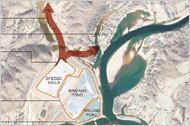Tennessee Coal Ash Flood Larger Than Initial Estimate
 A coal ash spill in eastern Tennessee that experts were already calling the largest environmental disaster of its kind in the United States is more than three times as large as initially estimated, according to an updated survey by the Tennessee Valley Authority.
A coal ash spill in eastern Tennessee that experts were already calling the largest environmental disaster of its kind in the United States is more than three times as large as initially estimated, according to an updated survey by the Tennessee Valley Authority. Officials at the authority initially said that about 1.7 million cubic yards of wet coal ash had spilled when the earthen retaining wall of an ash pond at the Kingston Fossil Plant, about 40 miles west of Knoxville, gave way on Monday. But on Thursday they released the results of an aerial survey that showed the actual amount was 5.4 million cubic yards, or enough to flood more than 3,000 acres one foot deep.
The amount now said to have been spilled is larger than the amount the authority initially said was in the pond, 2.6 million cubic yards.
A test of river water near the spill showed elevated levels of lead and thallium, which can cause birth defects and nervous and reproductive system disorders, said John Moulton, a spokesman for the T.V.A., which owns the electrical generating plant, one of the authority’s largest.
Mr. Moulton said Friday that the levels exceeded safety limits for drinking water, but that both metals were filtered out by water treatment processes.
Mercury and arsenic, he said, were “barely detectable” in the samples.
The ash pond was adjacent to the Emory River and near a residential area, where three houses were destroyed by the tide of muddy ash. Water sampled several miles downstream from the spill was safe to drink, but its iron and manganese content exceeded the secondary drinking water standards set by the Environmental Protection Agency, which govern taste and odor but not potential health effects, Mr. Moulton said.
Neither the authority nor the E.P.A. has released the results of tests of soil or the ash itself. Authority officials have said that the ash is not harmful, and the authority has not warned residents of potential dangers, though federal studies show that coal ash can contain dangerous levels of heavy metals and carcinogens.
“You’re not going to be endangered by touching the ash material,” said Barbara Martocci, a spokeswoman for the T.V.A. “You’d have to eat it. You have to get it in your body.”
The Tennessee Department of Environment and Conservation also released a statement saying there was no indication of risk unless the ash was ingested.
But residents like Deanna Copeland were thinking further into the future.
“Our concern is, what happens if this liquid dries out?” Ms. Copeland said. “There are huge health concerns. It’s going to get in our house. We’re going to breathe it in. It would be like walking through a dust bowl, and we don’t know what’s in the dust.”
A round-the-clock cleanup effort continued on Friday, much of it clearing roads and railway tracks that were blocked by the sludge. Several booms, or skimmers, were installed on nearby rivers to catch floating cenospheres, a valuable component of the ash used to make bowling balls and other manufactured goods. A weir, or underwater dam, that would keep settled ash from moving downstream was about one-fifth completed, T.V.A. officials said.
Some nearby residents said that the authority had done little to address their concerns.
“We’re terribly frustrated,” said Donald Smith, 58, a laboratory facilities manager who lives in the affected area. “It seems like T.V.A. is just throwing darts at the problem, and they don’t have a clue how to really fix it.
“It was nice that they came by to talk to us. They’re making an effort. But what upsets me is they didn’t have a plan in place. Why hadn’t anybody thought, ‘What happens if this thing bursts?’ “
Residents said they were stunned by the new figure for the size of the spill.
“That’s scary to know that they can be off by that much,” said Angela Spurgeon, whose dock and yard are swamped with ash. “I don’t think it was intentional, but it upsets me to know that a number was given of what the pond could hold, and the number now is more than double.”
Authority officials offered little explanation for the discrepancy, saying the initial number was an estimate based on their information at the time.
Ms. Spurgeon said the scope of the disaster was difficult to fathom, even from photos.
“This is not a thin coating of ash,” she said. “These are boulders. There’s one in our cove that’s probably the size of our home.”
The spill has reignited a debate over whether coal ash should be federally regulated as a hazardous material.
Environmentalists have long argued that coal ash, which can contaminate groundwater and poison aquatic environments, should be stored in lined landfills. The ash ponds at Kingston were separated from the river only by earthen dikes. Coal plants around the country, most near rivers that supply the water they need to operate, store coal ash in unlined embankments and ponds, and in some areas coal ash is recycled as fill material.
The T.V.A. is still investigating the cause of the breach, but officials have suggested that unusually heavy rain and freezing temperatures may have been factors.
By SHAILA DEWAN
For more information, Click Here.
You can return to the main Market News page, or press the Back button on your browser.

